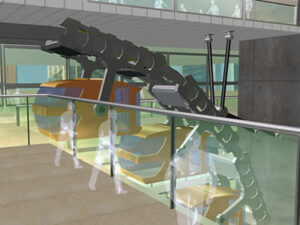According to the UN, by 2030 about 5 billion people are expected to live in cities. Together China, India, and Brazil are projected to have as many urban inhabitants as the entire developed world (Hinrichsen, 2002). The US National Transportation Board predicts that delays caused by congestion will increase by 5.6 billion hours in the period between 1995 and 2015 (Motavalli, 2002), while money and time spent in congestion amounts up to over $78 billion per year due to inefficiency. The unsustainable development and critical conditions found in present day mega-cities along with their inability to cope with the increasing demands imposed by contemporary modes of living are shaping urban settlements as an unstable equation.
The R&D Division at Serrano Pecorari & Asociados in reaction has proposed the 4D Cities Programme, which led to the conception and design of a set of projects rooted in this formulation of the urban manifesto. The 4D City Theory defines the re-conception of present cities under a new urban order, upgraded under a space-time equation, establishing a new-system of thought as well as a new economical and financial order which define urban structures within the established urban order and the paradigmatic shift in urban mobility. The designers propose thus a hyper-vertical building typology and a transportation system which may re-organise present infrastructures to guarantee inter connectivity- the Autonomous Transportation System(S.A.T. Project).

Whilst currently means of ground transportation work under a 2D-displacement, the S.A.T. proposes a Dimensional Public Private Transportation System, for people and freight. The System has the special feature of working under different directions of movement: horizontal, vertical( with no height limitations) and on a gradient. It comprises of unitary electric-vehicles that move along two tracks requiring minimum support, and made of materials that absorb vibrations and provide a cohesion-effect in every track section. A Central Control Unit manages the system without any human labour involved. It is powered by an electric engine, which is also used to reduce speed and regenerate energy, without causing noise or environmental pollution. Further, the project responds to an innovative public-private layout configuration, given its capacity to transcend the interaction between public and private arenas. It classifies as a massive transportation system, although given its dimensions, responds nearly to a private scale, transporting approximately 15 seated passengers per vehicle.
The project is patent registered internationally and the designers are currently seeking and evaluating strategic partnerships for prototype development and future implementation. A Joint International Co-operation Program with the Transportation Logistics Organisation at Delft University of Technology in the Netherlands has analyzed the performance and economical feasibility of S.A.T. under various case studies, demonstrating a better performance in comparison with present modes of mass transportation.
Project Details:
Project Name: S.A.T. Project
Project Type: Public-Private Transportation System
Principal Designer: Jorge Serrano
Design Team: R&D Division, Serrano Pecorari & Associates
Year of commencement of project: 1999
Year of completion of project: 2000, Patent registered internationally
Credits:
Text: Courtesy of the architect
Computer Renderings by Asermax Digital Modeling, Courtesy of the architect
Compiled and edited by Manish Mehta
